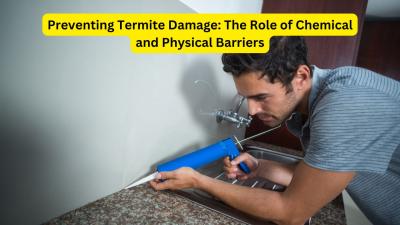Preventing Termite Damage: Role of Chemical & Physical Barriers
-
Termites are often referred to as "silent destroyers" due to their ability to cause significant damage to homes and other structures without being detected until the damage is extensive. As they feed on wood and other cellulose materials, termite infestations can lead to costly repairs and structural issues. Preventing termite damage is crucial for homeowners, especially in areas like the Gold Coast, where the warm climate can promote termite activity. One of the most effective strategies involves the use of chemical and physical barriers, commonly referred to as termite barriers. This article will delve into the role these barriers play in termite prevention and offer insights into how they can safeguard your property.
Understanding Termite Behavior
To appreciate the significance of barriers in termite prevention, it’s essential to understand termite behavior. Termites thrive in warm, moist environments, and they typically enter homes through the soil. They build tunnels to travel between their nests and food sources, often going unnoticed. Two main types of termites pose threats to structures:
-
Subterranean Termites: These termites live underground and build mud tubes to access wood. They are the most common type of termite in the United States and can cause extensive damage as they can consume wood quickly.
-
Drywood Termites: Unlike subterranean termites, drywood termites live within the wood they consume, making detection more challenging. They can infest homes without any contact with the soil.
To effectively prevent termite damage, it's crucial to employ a combination of strategies, including the installation of chemical and physical barriers.
Chemical Barriers
Chemical barriers involve the application of termiticides, which are chemical agents specifically designed to kill or repel termites. These barriers can be applied in various ways, offering flexibility depending on the needs of the property. Here are the primary types of chemical barriers used in termite prevention:
1. Soil Treatments
Soil treatments are commonly used around the foundation of a home. A professional pest control technician applies termiticides directly to the soil before construction or during a treatment plan. These chemicals create a barrier that prevents termites from entering the home through the ground.
Application Process:
- Trenching: The technician digs a trench around the foundation, usually about six inches deep. The termiticide is then applied to this trench and the soil beneath it.
- Injection: In some cases, the termiticide may be injected into the soil using specialized equipment. This method allows for more precise application and can be effective in treating existing infestations.
Benefits:
- Long-lasting Protection: Many modern termiticides can provide protection for several years, especially when properly applied.
- Versatile Options: Homeowners can choose between liquid or foam treatments based on their specific needs.
2. Baiting Systems
Baiting systems are another chemical barrier option that involves placing bait stations around the perimeter of a property. These stations contain slow-acting termiticides that termites consume and carry back to their colonies, ultimately killing the entire colony.
How They Work:
- Station Installation: Bait stations are strategically installed in areas where termite activity is suspected or near wood structures.
- Monitoring: Regular monitoring of bait stations allows homeowners to detect termite activity early and take appropriate action.
Benefits:
- Environmentally Friendly: Baiting systems often use lower concentrations of chemicals compared to traditional soil treatments, making them a more eco-friendly option.
- Effective for Existing Infestations: Baiting systems can effectively eliminate active colonies, reducing the risk of future damage.
Physical Barriers
Physical barriers are an essential part of a comprehensive termite prevention plan. These barriers involve using materials that termites cannot penetrate, effectively blocking their entry into structures. Here are some common types of physical barriers used in termite prevention:
1. Steel Mesh Barriers
Steel mesh barriers consist of fine mesh materials installed in areas where termites might enter, such as around pipes, vents, and the foundation of a building.
Installation Process:
- The mesh is installed at the construction phase, but existing structures can also be retrofitted with steel mesh in vulnerable areas.
Benefits:
- Durable and Long-lasting: Steel mesh is resistant to damage and can last for many years without requiring replacement.
- Non-toxic Solution: Unlike chemical treatments, steel mesh does not involve any harmful chemicals, making it a safe choice for families and pets.
2. Concrete and Physical Barriers
Using concrete as a barrier is another effective method to prevent termite entry. This can involve pouring concrete footings and slabs that provide a solid foundation for structures, making it difficult for termites to penetrate.
Benefits:
- Natural Barrier: Concrete is a natural termite barrier that can effectively prevent subterranean termites from accessing wooden structures.
- Enhanced Structural Integrity: In addition to pest prevention, concrete provides added strength and stability to buildings.
3. Barrier Products
Various barrier products are available on the market, specifically designed to prevent termite entry. These products can include treated wood, borate-treated wood, and plastic sheeting designed to block termites.
Benefits:
- Customizable Solutions: Homeowners can select products based on their specific needs and the unique characteristics of their properties.
- Integrated Protection: Combining different barrier products can enhance overall protection against termite damage.
Integrated Pest Management
While chemical and physical barriers play a vital role in preventing termite damage, an integrated pest management (IPM) approach is recommended for the best results. This strategy combines multiple methods for termite control, including:
-
Regular Inspections: Conducting annual inspections by a qualified pest control professional can help identify potential risks and address any early signs of infestation.
-
Moisture Control: Since termites thrive in moist environments, managing moisture levels around your home is crucial. Repairing leaks, improving drainage, and ensuring proper ventilation can significantly reduce termite attraction.
-
Reducing Wood-to-Ground Contact: Storing firewood away from the home, using treated wood for decks and fences, and keeping mulch away from the foundation can limit termite access.
-
Educating Homeowners: Knowledge about termite behavior and prevention techniques empowers homeowners to take proactive measures against infestations.
Conclusion
-
